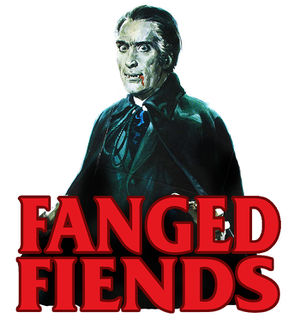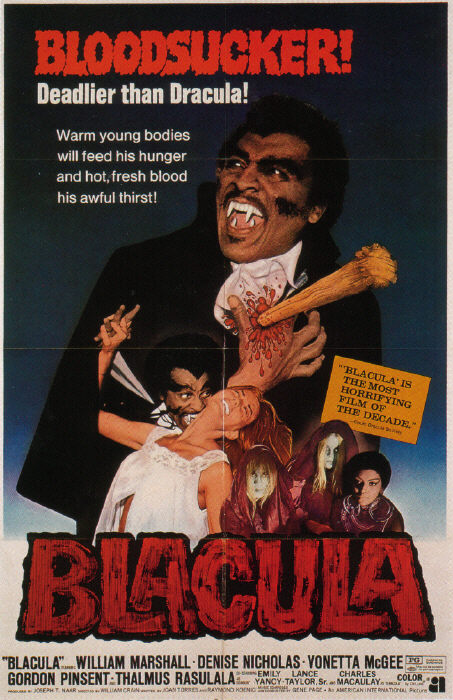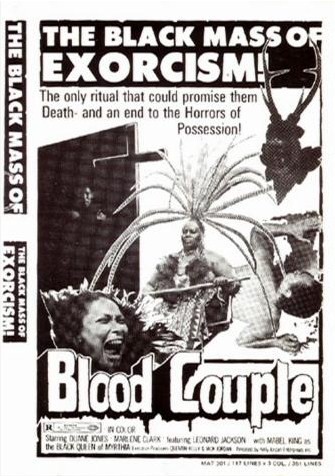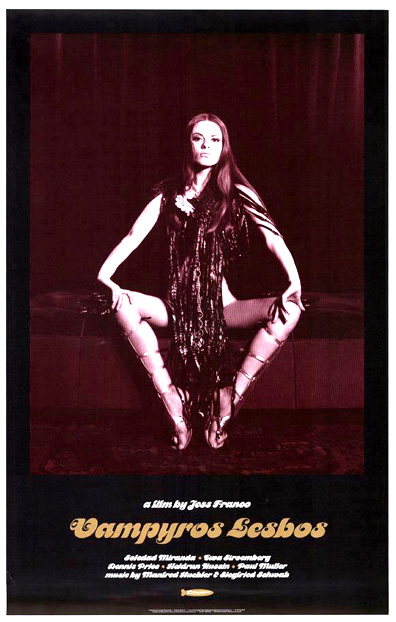Difference between revisions of "Fanged Fiends: 10 Vampire Classics"
From The Grindhouse Cinema Database
PopeyePete (talk | contribs) |
PopeyePete (talk | contribs) |
||
| Line 1: | Line 1: | ||
{{Under Construction}} | {{Under Construction}} | ||
The '''[[:Category:Vampires|Vampire]]''' subgenre is one of the oldest and most | [[File:Chrisleedrac1.jpg|300px|right]] The '''[[:Category:Vampires|Vampire]]''' subgenre is one of the oldest and most celebrated in horror cinema history. Starting with such early hits as F.W. Murnau's Nosferatu (1922) starring Max Schreck and Tod Browning's Dracula (1931) starring the legendary Bela Lugosi, these tales of evil bloodsucking creatures thrilled audiences around the world. A few decades later, Britain's [[:Category:Hammer Studios|Hammer Studios]] caused a resurgence with their immensely popular Dracula series starring the late great [[Christopher Lee]]. In the 21st century the creepy characters that crave blood, transform into bats, hate garlic and holy water continue to thrive in popular culture. Recently, GCDB picked 10 our of our favorite classic vampire themed exploitation & cult films. We urge you to check them out. | ||
====[[Dracula|Dracula (1958)]]==== | ====[[Dracula|Dracula (1958)]]==== | ||
Revision as of 18:01, 3 October 2015
The Vampire subgenre is one of the oldest and most celebrated in horror cinema history. Starting with such early hits as F.W. Murnau's Nosferatu (1922) starring Max Schreck and Tod Browning's Dracula (1931) starring the legendary Bela Lugosi, these tales of evil bloodsucking creatures thrilled audiences around the world. A few decades later, Britain's Hammer Studios caused a resurgence with their immensely popular Dracula series starring the late great Christopher Lee. In the 21st century the creepy characters that crave blood, transform into bats, hate garlic and holy water continue to thrive in popular culture. Recently, GCDB picked 10 our of our favorite classic vampire themed exploitation & cult films. We urge you to check them out.
Dracula (1958)
Following Curse of Frankenstein in 1957 Hammer studios re-united director, screenwriter, stars and crew to resurrect another classic literary monster and with 'Dracula' (released as 'The Horror Of Dracula' in the U.S. to avoid confusion with the 1931 Bela Lugosi version) sealed the deal on their reputation as masters of Technicolor Gothic horror. After a decade of atomically enlarged insects and invaders from outer space Hammer studios almost single-handedly turned the tide of cinema fantasy and their particular brand of grim fairytale would enjoy massive box office success for almost 20 years. Other adaptations may have stuck more closely to the plot of the book but none have so successfully translated such excitement, tension and drama to the screen. All the elements that would quickly become Hammer trademarks are present here: James Bernard's baroque ‘bat out of hell’ score, the cleverly nuanced performances of beloved stars Peter Cushing and Christopher Lee, and the exquisitely detailed sets courtesy of production designer Bernard Robinson. 'Dracula' stands as one of the highlights in Hammer's fantastic filmography.
Brides of Dracula (1960)
Despite Christopher Lee’s refusal to reprise his role as the caped Count Hammer studios proceeded with a follow up to their 1958 box office hit Dracula without him and the result is one of the company’s most exciting, suspenseful and visually enchanting productions. A voiceover narration informs us that although the lord of the undead Count Dracula has been destroyed his vampire spawn are still at large. ‘Brides of Dracula’ is full of stunning set pieces and Terence Fisher’s direction confidently builds the suspense and drives the action. Highlights include: the graveyard birth of the vampire girl; Van Helsing purging himself of a vampire bite with a hot branding iron and a splash of holy water; and the climatic use of a windmill’s sails to cast a shadow over the blood-sucking Baron. Bernard Robinson’s extraordinarily detailed set designs even manage to surpass those of the previous film. The windmill set especially is an abundantly cobwebbed work of art. Director of photography Jack Asher’s use of candy coloured spotlights in certain key scenes adds to the fairy tale ambience in a way that would later become a trademark of Mario Bava’s gothic fever dreams. Costumes, make-up and music are all sublime and for many of Hammer’s skilled technicians this film may well contain their best work.
Blacula (1972)
In the year 1790, African Prince Mamuwalde (William Marshall) and his wife Luva (Vonetta McGee) visit the country of Transylvania and its most popular resident, Count Dracula (Charles Macaulay) in an effort to get help to end the slave trade. It is soon revealed that ol' Dracula himself is a racist. When Mamuwalde and Luva attempt to leave the castle, they are swiftly held captive by Dracula's vampire minions. Count Dracula bites Mamuwalde turning him into a vampire and curses him with the name "Blacula". After locking Mamuwalde into a metal coffin, Dracula lets Luva know that her fate is sealed as well, and the two are placed inside a hidden dungeon room, never to be seen again. Centuries later, Blacula is unleashed onto America's urban landscape where he stalks the night, sucking the blood of unassuming citizens. When Blacula was released it was a box office success and was immediately followed by a sequel Scream Blacula Scream co-starring Pam Grier. William Crain's sharp direction, along with the funky music score by Gene Page, and of course the late William Marshall's memorable lead performance make this film a classic of the 70s Blaxploitation genre. Highly recommended!
Count Yorga, Vampire (1971)
While owing its roots more towards traditional horror films, Count Yorga, Vampire could almost be known as a serious spoof of such films. Instead of going the tongue-in-cheek route with the script, the film takes its story seriously, while somehow managing to turn all the normal conventions of horror films on their ears. Half of the film seems to be spent having the character Dr. Hayes trying to convince all the other disbelieving characters that vampires could actually exist and that one is responsible for everything that is going on. He doesn't do it with the wild eyed raving of a madman either, but with calm, rational explanations of the legend of vampires and how one could exist in the present day. To the screenwriters credit, none of the characters relent on their skepticism (not even the police, whom Hayes routinely tries to contact over the matter), even as Hayes has them getting ready to commit murder in order to prove him right. Even early on, during the seance scenes, the characters refuse to believe in the supernatural and make jokes all throughout the ceremony which end up closing down the proceedings early. While none of this may seem totally fresh to those brought up on horror films of the late eighties and nineties, for its time, Count Yorga was slightly revolutionary.
Ganja & Hess (1973)
Ganja and Hess was originally supposed to be a standard Blaxploitation film, but Writer-Director Bill Gunn, decided to go in another direction completely. The result is one of the most unique and intelligently crafted films to come out of the 1970s cinema explosion. Kelly Jordan Enterprises (the company that produced it) were not happy with the arthouse nature of the film. They took the picture out of theaters after only a week and then recut the film from 110 minutes to 78 minutes to try to turn it into a typical Grindhouse-Drive In format. Writer Director Bill Gunn removed his name from the other version. The film is a vampire story, but in no way a conventional one. Dr. Hess Green (Night of the Living Dead's Duane Jones) is a doctor of anthropology. While in Africa he was stabbed by an ancient Merthian dagger that was diseased with the plague of vampirism. He has returned to the USA and he has become a vampire who needs human blood to survive. Hess is falling deeper into the life of being a non-human, but tries to deal with the evil possession by attending church services in between killing and looking for blood by any means. There are no bats, no quirky transformations in the film, the vampires portrayed in this film are really metaphors for addictions everyone has, they need blood like junkies need heroin.
Lifeforce (1985)
A joint US-UK crew on board the nuclear-powered space shuttle Churchill is on a mission to investigate Halley's Comet under the command of US Air Force Colonel Thomas Wolfe Carlsen (Steve Railsback). They find a 150-mile long alien spaceship hidden in the comet's corona, seemingly derelict. Upon entering the spacecraft, the crew finds hundreds of dead, shriveled bat-like creatures and three naked humanoid bodies (two male and one female) in suspended animation within glass containers. The crew recovers the three aliens and begins the return trip to Earth. It transpires that the aliens are in fact part of a race of space vampires that consume the life force of living beings, rather than their blood. Prior to an autopsy, the female alien (May), referred to throughout the film as the Space Girl, awakens and fully drains the "life force" out of a guard, as well as some extra energy from the intervening Bukovsky. The Space Girl then escapes the research facility and proceeds to drain various other humans of their life force, revealing in the interim an ability to shape-shift. To make matters worse, their victims, which are in a mummified state when completely drained, are temporarily revived as zombies that are also capable of draining others of their life forces, each victim needing a regular infusion of life energy every two hours lest they disintegrate or explode into clouds of ash. (Wikipedia)
Martin (1977)
Martin (John Amplas) goes to live with his older cousin, who believes that he is a vampire. Martin has to get through lots of things as his past is slowly revealed to us. This is one of those films that I can't explain clearly unless you've seen it before because there are strange things that happen and makes us suspicious about Martin. Just look at the first scene, he breaks into a young woman's cabin on a train. Then he injects narcotics into her body, slices her arm with a razor blade and drinks her blood. It makes the audience wonder why he has to do this. Is he a real vampire? Later, we find out that he's not a "traditional" vampire since garlic, mirrors and a crucifix at his cousin's house does nothing to him. Martin's story is also told from two perspectives. First, it has Martin struggling in the modern world, which is represented in color. Then the picture in Martin's mind that is told in Black and White (a kind of "VampireVision"). Most of stuff we see in VampireVision are the things that Martin sees, but clothes and objects are shown in 18-19th century renditions which means that either these things actually happened to him before or this is just how he interprets the world.
Vampire Circus (1972)
After a mob vanquishes a child-killing vampire named Count Mitterhaus (Robert Tayman), The Count's last words not only predict a curse upon the town, but that the children of his killers will all die to make way for the return of The Count. Fifteen years later, the prophecy looks to have come true. A rampant plague has been killing off much of the inhabitants in the English town. It's gotten so bad that the entire town is quarantined. Complete with roadblocks on which sentry men are ordered to shoot deserters on sight! These poor people are overdue for some enlightment! And that enlightment finally happens to appear in the form of a traveling circus, led by a Gypsy (Adrienne Corri) The townspeople are in awe of the wonderous accomplishments of the troupe, which include a trapeze sibling act and a shape-shifting panther, who's human incarnation is the suave Emil (Anthony Higgins). Though the crowd assumes that the act is all done by incredible illusions, it shouldn't be too much of a surprise to know that the supernatural is involved with this circus act.
The Seven Brothers Meet Dracula (1974)
This film was one half of a 2 picture co-production deal between Hammer & Shaw Bros the other being the espionage thriller Shatter staring Stuart Whitman. Shot partly on location but mostly at Shaw Bros studios in Hong Kong, by all accounts production (on both films) was difficult for all concerned. Shaw Bros star director Chang Cheh was brought in at Run Run Shaw’s insistence to re-shoot some of ‘Legend of the 7 Golden Vampires’ fight scenes and the film soon went over budget. Despite the involvement of many Hammer regulars behind the scenes the film bears little resemblance to previous entries in the studios Dracula series which makes the harsh criticism it has received from Hammer purists rather redundant. Legend of the 7 Vampires (or The 7 Brothers Meet Dracula as it eventually became known in a re-edited form in the U.S.) is without question a Shaw Bros film albeit with Hammer horror guest stars. The plot is perfunctory and the script generally bland and frequently nonsensical however, as in all Shaw Bros productions at that time, the frantic action and outrageous visual excesses are given precedence and when judged on these aspects the film is a resounding and mightily entertaining success.
Vampyros Lesbos (1970)
On a remote island, beautiful bloodsucker Countess Nadine Carody (Soledad Miranda) lures unwary victims with her seductive nightclub act and sets her sights on Linda (Ewa Strömberg). Linda begins having dreams about Nadine, and seeks her home on an island. She is interrupted by Memmet (Jess Franco) who warns her not to go to the island. Linda follows Memmet to his chamber where she walks in on him torturing a young woman. She escapes this encounter and proceeds to the island. On the Island, Linda meets Nadine. The two go swimming and Nadine notes that the home they are staying at used to belong to Count Dracula. Vampyros Lesbos was filmed in Turkey between June 1, 1970 and July 10, 1970. Director Jess Franco applied film devices that were used in his previous film such as long strip club sequences and female protagonists while the lesbian subtext was more prominent in this film than any previous work. The music score also differs from the jazz soundtracks of his previous films with a more psychedelic music influenced soundtrack. It was composed by Manfred Hübler, Siegfried Schwab and Jesús Franco who credited himself under the alias of David Khune. The film went under several titles before being released as Vampyros Lesbos including 'Das Mal des Vampirs (Evil of the Vampires) and Im Zeichen der Vampire (Mark of the Vampire). (Wikipedia)




























